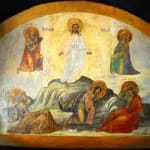The Transfiguration of Christ, 19th Century CE
Oil on Wood Panel
19
PF.5962
Further images
Russians inherited the tradition of icon painting from Byzantium, where it began as an offshoot of the mosaic and fresco tradition. During the 8th and 9th centuries, the iconoclastic controversy...
Russians inherited the tradition of icon painting from Byzantium, where it began as an offshoot of the mosaic and fresco tradition. During the 8th and 9th centuries, the iconoclastic controversy in the Orthodox Church called into question whether religious images were a legitimate practice or sacrilegious idolatry. Although the use of images was in the end permitted, a thorough distinction between profane art intended to depict reality and sacred art designed for spiritual contemplation was established. Certain kinds of balance and harmony became established as reflections of divinity, and as such they invited careful reproduction and subtle refinement rather than striking novelty. Although this philosophy resulted in a comparatively slow evolution of style, icon painting evolved considerably over the centuries. Unlike the pictorial traditions of the west that aspire towards increased realism and naturalism, the essence of Russian icon painting is not about the representation of physical space or appearance. Icons are images intended to aid in contemplative prayer, and in that sense, are more concerned with conveying meditative harmony than with laying out a realistic scene. They were not painted to please the eye of the mind, but to inspire reflection and self-examination.
Christ lead his most intimate followers Peter, James, and John high upon a mountain and there, his divinity was revealed to them. The light of the heaven shone from within Christ and his clothes turned to white. There appeared the prophets Moses and Elijah who conversed with Christ. Christ’s divinity now became clear to his disciples who were unable to bear looking at the illumination of divine majesty. This icon masterfully represents this popular scene. Golden lines of light radiate from Christ’s body who appears calm and commanding. The artist has clearly delineated the composition into the realm of the terrestrial and the divine. While Moses and Elijah hover up on the clouds, it is only Christ who can penetrate the two realms. As he stands on the top of the mountain, he also shines with the blinding glow of the heavens.
Christ lead his most intimate followers Peter, James, and John high upon a mountain and there, his divinity was revealed to them. The light of the heaven shone from within Christ and his clothes turned to white. There appeared the prophets Moses and Elijah who conversed with Christ. Christ’s divinity now became clear to his disciples who were unable to bear looking at the illumination of divine majesty. This icon masterfully represents this popular scene. Golden lines of light radiate from Christ’s body who appears calm and commanding. The artist has clearly delineated the composition into the realm of the terrestrial and the divine. While Moses and Elijah hover up on the clouds, it is only Christ who can penetrate the two realms. As he stands on the top of the mountain, he also shines with the blinding glow of the heavens.







